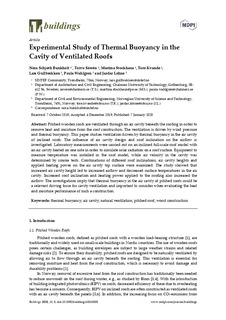| dc.contributor.author | Bunkholt, Nora Schjøth | |
| dc.contributor.author | Säwén, Toivo | |
| dc.contributor.author | Stockhaus, Martina | |
| dc.contributor.author | Kvande, Tore | |
| dc.contributor.author | Gullbrekken, Lars | |
| dc.contributor.author | Wahlgren, Paula | |
| dc.contributor.author | Lohne, Jardar | |
| dc.date.accessioned | 2020-01-14T09:17:33Z | |
| dc.date.available | 2020-01-14T09:17:33Z | |
| dc.date.created | 2020-01-13T11:01:21Z | |
| dc.date.issued | 2020 | |
| dc.identifier.issn | 2075-5309 | |
| dc.identifier.uri | http://hdl.handle.net/11250/2636111 | |
| dc.description.abstract | Pitched wooden roofs are ventilated through an air cavity beneath the roofing in order to remove heat and moisture from the roof construction. The ventilation is driven by wind pressure and thermal buoyancy. This paper studies ventilation driven by thermal buoyancy in the air cavity of inclined roofs. The influence of air cavity design and roof inclination on the airflow is investigated. Laboratory measurements were carried out on an inclined full-scale roof model with an air cavity heated on one side in order to simulate solar radiation on a roof surface. Equipment to measure temperature was installed in the roof model, while air velocity in the cavity was determined by smoke tests. Combinations of different roof inclinations, air cavity heights and applied heating power on the air cavity top surface were examined. The study showed that increased air cavity height led to increased airflow and decreased surface temperatures in the air cavity. Increased roof inclination and heating power applied to the roofing also increased the airflow. The investigations imply that thermal buoyancy in the air cavity of pitched roofs could be a relevant driving force for cavity ventilation and important to consider when evaluating the heat and moisture performance of such a construction. | nb_NO |
| dc.language.iso | eng | nb_NO |
| dc.publisher | MDPI | nb_NO |
| dc.rights | Navngivelse 4.0 Internasjonal | * |
| dc.rights.uri | http://creativecommons.org/licenses/by/4.0/deed.no | * |
| dc.title | Experimental Study of Thermal Buoyancy in the Cavity of Ventilated Roofs | nb_NO |
| dc.type | Journal article | nb_NO |
| dc.type | Peer reviewed | nb_NO |
| dc.description.version | publishedVersion | nb_NO |
| dc.source.volume | 10 | nb_NO |
| dc.source.journal | Buildings | nb_NO |
| dc.source.issue | 8 | nb_NO |
| dc.identifier.doi | 10.3390/buildings10010008 | |
| dc.identifier.cristin | 1771211 | |
| dc.relation.project | Norges forskningsråd: 237859 | nb_NO |
| dc.description.localcode | © 2020by the authors. Licensee MDPI, Basel, Switzerland. This article is an open access article distributed under the terms and conditions of the Creative Commons Attribution (CC BY) license (http://creativecommons.org/licenses/by/4.0/) | nb_NO |
| cristin.unitcode | 194,64,91,0 | |
| cristin.unitname | Institutt for bygg- og miljøteknikk | |
| cristin.ispublished | true | |
| cristin.fulltext | original | |
| cristin.qualitycode | 1 | |

